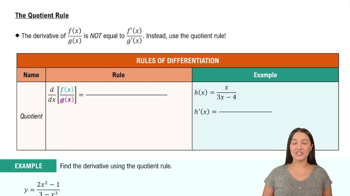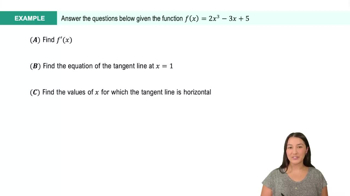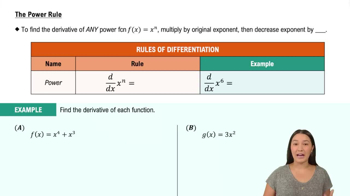Table of contents
- 0. Functions7h 52m
- Introduction to Functions16m
- Piecewise Functions10m
- Properties of Functions9m
- Common Functions1h 8m
- Transformations5m
- Combining Functions27m
- Exponent rules32m
- Exponential Functions28m
- Logarithmic Functions24m
- Properties of Logarithms34m
- Exponential & Logarithmic Equations35m
- Introduction to Trigonometric Functions38m
- Graphs of Trigonometric Functions44m
- Trigonometric Identities47m
- Inverse Trigonometric Functions48m
- 1. Limits and Continuity2h 2m
- 2. Intro to Derivatives1h 33m
- 3. Techniques of Differentiation3h 18m
- 4. Applications of Derivatives2h 38m
- 5. Graphical Applications of Derivatives6h 2m
- 6. Derivatives of Inverse, Exponential, & Logarithmic Functions2h 37m
- 7. Antiderivatives & Indefinite Integrals1h 26m
- 8. Definite Integrals4h 44m
- 9. Graphical Applications of Integrals2h 27m
- 10. Physics Applications of Integrals 2h 22m
3. Techniques of Differentiation
Basic Rules of Differentiation
Problem 3.4.41
Textbook Question
Derivatives Find and simplify the derivative of the following functions.
g(t) = 3t² + 6/t⁷
 Verified step by step guidance
Verified step by step guidance1
Step 1: Identify the function components. The function is g(t) = 3t^2 + 6/t^7. It consists of two terms: 3t^2 and 6/t^7.
Step 2: Rewrite the function for easier differentiation. The term 6/t^7 can be rewritten using negative exponents as 6t^(-7). So, g(t) = 3t^2 + 6t^(-7).
Step 3: Differentiate each term separately. Use the power rule for differentiation, which states that the derivative of t^n is n*t^(n-1).
Step 4: Apply the power rule to the first term. The derivative of 3t^2 is 2*3*t^(2-1) = 6t.
Step 5: Apply the power rule to the second term. The derivative of 6t^(-7) is -7*6*t^(-7-1) = -42t^(-8).
 Verified video answer for a similar problem:
Verified video answer for a similar problem:This video solution was recommended by our tutors as helpful for the problem above
Video duration:
4mPlay a video:
Was this helpful?
Key Concepts
Here are the essential concepts you must grasp in order to answer the question correctly.
Derivatives
A derivative represents the rate of change of a function with respect to its variable. It is a fundamental concept in calculus that allows us to determine how a function behaves at any given point. The derivative is often denoted as f'(x) or df/dx, and it can be interpreted as the slope of the tangent line to the curve of the function at a specific point.
Recommended video:

Derivatives
Power Rule
The Power Rule is a basic differentiation rule used to find the derivative of functions in the form of x^n, where n is a real number. According to this rule, the derivative of x^n is n*x^(n-1). This rule simplifies the process of differentiation, especially for polynomial functions, making it easier to compute derivatives quickly.
Recommended video:
Guided course

Power Rules
Quotient Rule
The Quotient Rule is a method for differentiating functions that are expressed as the ratio of two other functions. If a function is defined as f(x) = u(x)/v(x), where both u and v are differentiable, the derivative is given by (v*u' - u*v')/v². This rule is essential when dealing with rational functions, allowing for the correct computation of their derivatives.
Recommended video:

The Quotient Rule

 3:59m
3:59mWatch next
Master Derivatives of Linear Functions with a bite sized video explanation from Callie
Start learningRelated Videos
Related Practice







